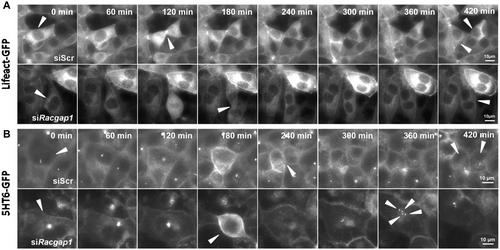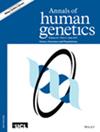Racgap1 knockdown results in cells with multiple cilia due to cytokinesis failure
IF 1.2
4区 生物学
Q4 GENETICS & HEREDITY
引用次数: 0
Abstract
Most mammalian cells have a single primary cilium that acts as a signalling hub in mediating cellular functions. However, little is known about the mechanisms that result in aberrant supernumerary primary cilia per cell. In this study, we re-analysed a previously published whole-genome siRNA-based reverse genetic screen for genes mediating ciliogenesis to identify knockdowns that permit multi-ciliation. We identified siRNA knockdowns that caused significant formation of supernumerary cilia, validated candidate hits in different cell-lines and confirmed that RACGAP1, a component of the centralspindlin complex, was the strongest candidate hit at the whole-genome level. Following loss of RACGAP1, mother centrioles were specified correctly prior to ciliogenesis and the cilia appeared normal. Live cell imaging revealed that increased cilia incidence was caused by cytokinesis failure which led to the formation of multinucleate cells with supernumerary cilia. This suggests that the signalling mechanisms for ciliogenesis are unable to identify supernumerary centrosomes and therefore allow ciliation of duplicated centrosomes as if they were in a new diploid daughter cell. These results, demonstrating that aberrant ciliogenesis is de-coupled from cell cycle regulation, have functional implications in diseases marked by centrosomal amplification.

Racgap1敲低导致细胞由于胞质分裂失败而具有多个纤毛。
大多数哺乳动物细胞都有一个初级纤毛,作为介导细胞功能的信号中枢。然而,对于导致每个细胞异常多生初级纤毛的机制知之甚少。在这项研究中,我们重新分析了之前发表的一项基于全基因组siRNA的反向遗传筛选,以筛选介导纤毛形成的基因,从而确定允许多纤毛的敲除。我们鉴定了导致大量纤毛形成的siRNA敲除,验证了不同细胞系中的候选命中,并证实了中心刺蛋白复合体的一种成分RACGAP1是全基因组水平上最强的候选命中。RACGAP1缺失后,在纤毛形成前正确指定了母体中心粒,纤毛表现正常。活细胞成像显示,纤毛发生率的增加是由胞质分裂失败引起的,胞质分裂衰竭导致形成多核细胞和多余的纤毛。这表明纤毛形成的信号机制无法识别多余的中心体,因此允许复制的中心体像在新的二倍体子细胞中一样进行纤毛。这些结果表明,异常的纤毛形成与细胞周期调节是解耦的,在以中心体扩增为标志的疾病中具有功能意义。
本文章由计算机程序翻译,如有差异,请以英文原文为准。
求助全文
约1分钟内获得全文
求助全文
来源期刊

Annals of Human Genetics
生物-遗传学
CiteScore
4.20
自引率
0.00%
发文量
34
审稿时长
3 months
期刊介绍:
Annals of Human Genetics publishes material directly concerned with human genetics or the application of scientific principles and techniques to any aspect of human inheritance. Papers that describe work on other species that may be relevant to human genetics will also be considered. Mathematical models should include examples of application to data where possible.
Authors are welcome to submit Supporting Information, such as data sets or additional figures or tables, that will not be published in the print edition of the journal, but which will be viewable via the online edition and stored on the website.
 求助内容:
求助内容: 应助结果提醒方式:
应助结果提醒方式:


